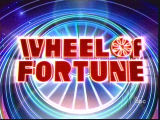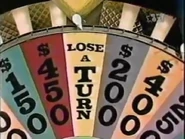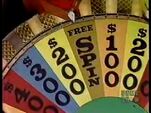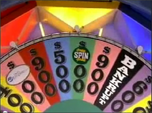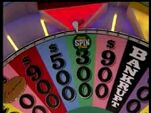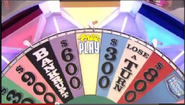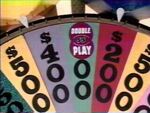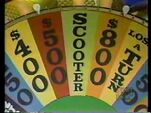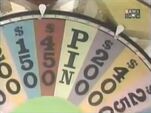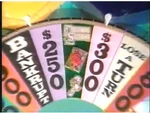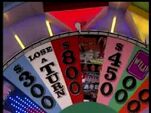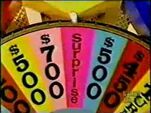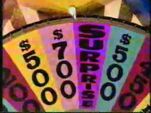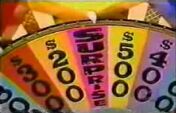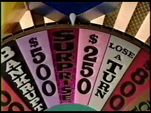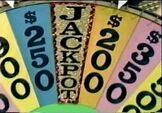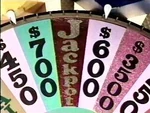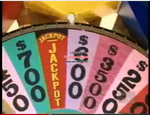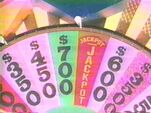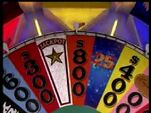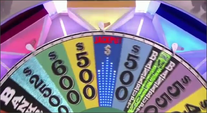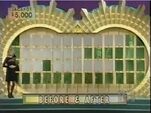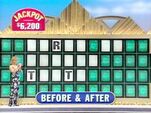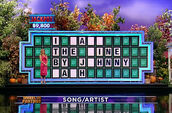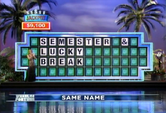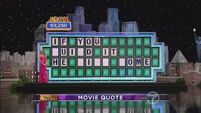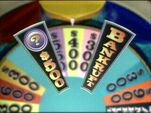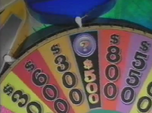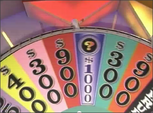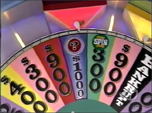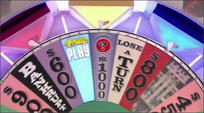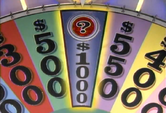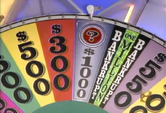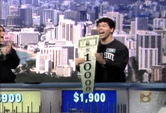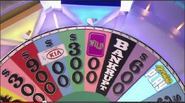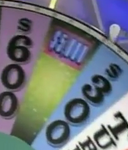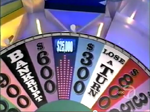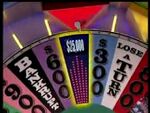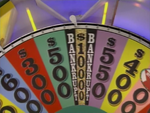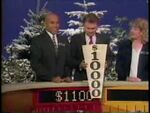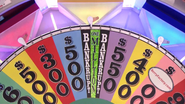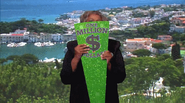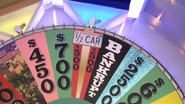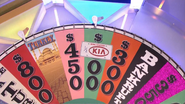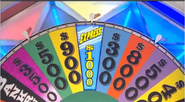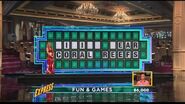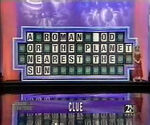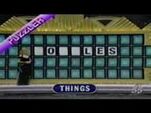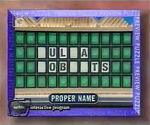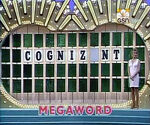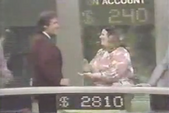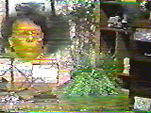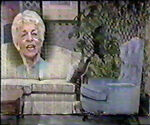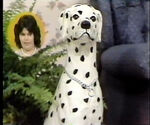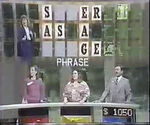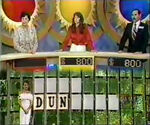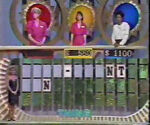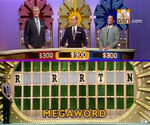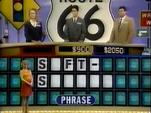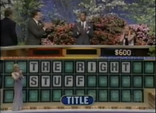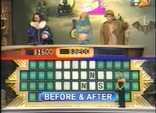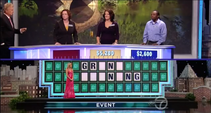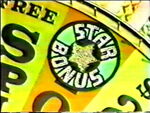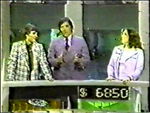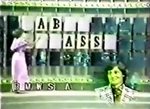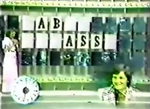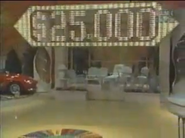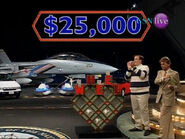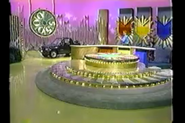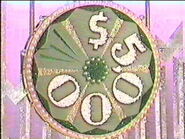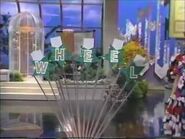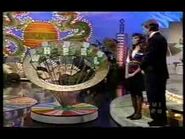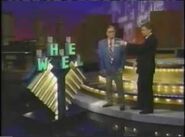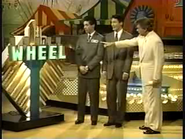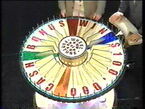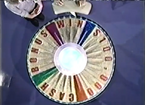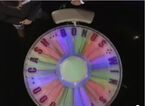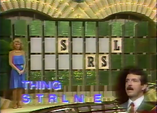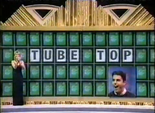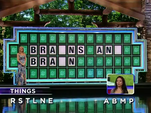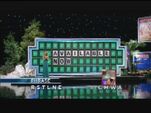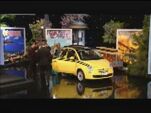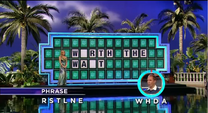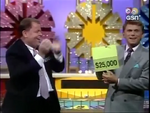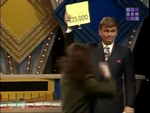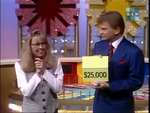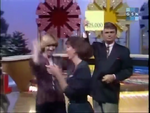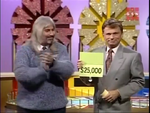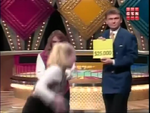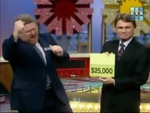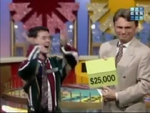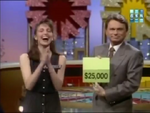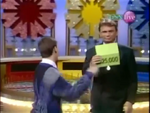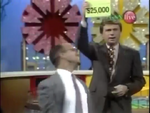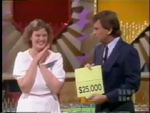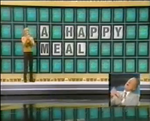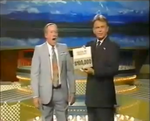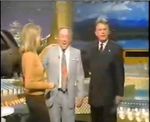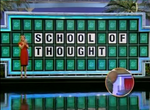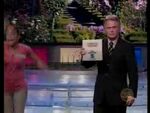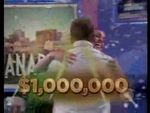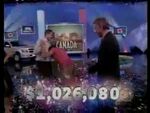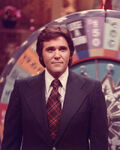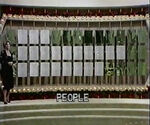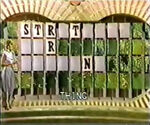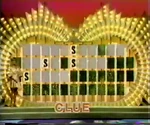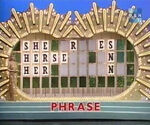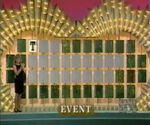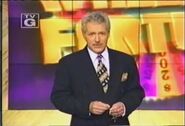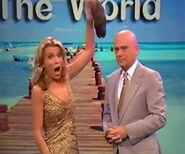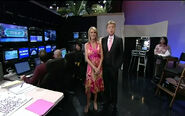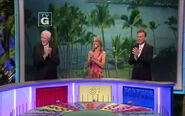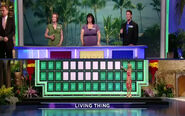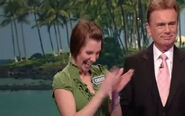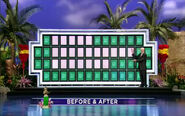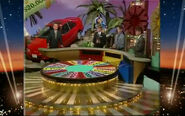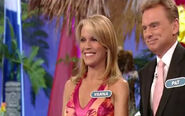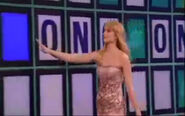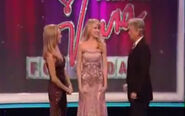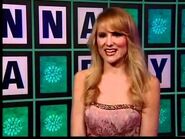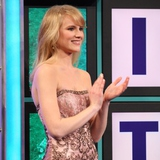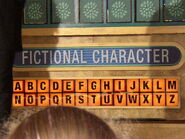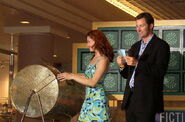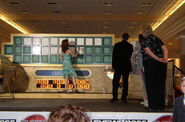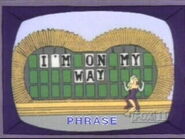| Hosts | |
|
Edd "Kookie" Byrnes (1974) | |
| Hostesses | |
|
Susan Stafford (1974-82, 6/16-20/1986) | |
| Announcers | |
|
Charlie O'Donnell (1974-80, 1985, 1989-2010) | |
| Broadcast | |
| NBC Pilot: 8/28/1974 NBC: 1/6/1975-6/30/1989, 1/14-9/20/1991 CBS: 7/17/1989-1/11/1991 Syndicated: 9/19/1983-present | |
| Packagers | |
| Merv Griffin Productions/Enterprises (1974-94) Columbia TriStar Television (1994-2002) Sony Pictures Television (2002-) | |
| Distributors | |
| King World (1983-2007) CBS Television Distribution (2007-) | |
The long-running game show in which three contestants spin a giant wheel and solve Hangman-type puzzles to win thousands of dollars in cash & prizes.
Gameplay
In each round, a puzzle was revealed followed by the category to that puzzle. The player in control spun a large wheel which is fully calibrated with dollar amounts and penalty spaces (Bankrupt & Lose a Turn). When the wheel landed on a dollar amount, he/she then called a letter. If the letter is in the puzzle he/she earned the amount times the number of appearances of that letter and continued his/her turn. Along the way he/she can buy a vowel which costs $250 ($200, later $100 on Bob Goen's version) each no matter how many there are or if it appeared in the puzzle or not. If at any point the contestant in control picked a letter that was not in the puzzle, picked a letter that was already called, picked a vowel instead of a consonant after spinning, solved the puzzle incorrectly or if he/she hit Lose a Turn, that player lost his turn and control went over the next player in line; if the player hit "Bankrupt", the player in control loses all his/her money and his/her turn. Previously in the first round there was only one Bankrupt, and there were at least two with each subsequent round. Since Season 27, there has always been at least two Bankrupts throughout the entire game. The first player to solve the puzzle won the round and kept all the money earned in that round with a minimum guarantee on each version:
| Years | Single player | Team |
|---|---|---|
| 1983~1995 | $200 | $400 |
| 1995~2005 | $500 | $1,000 |
| 2005~current | $1,000 | $2,000 |
Celebrity Shows
Most shows will have celebrities playing along with the contestants. The contestants play for themselves and keep whatever cash and prizes they earn, while the celebrities play for charity where each team's winnings are matched and donated in cash to a charity or charities of the celebrities' choices, with a minimum guarantee of $10,000. In the early days of celebrity appearances on the show, the celebrities played by themselves.
Special Wheel Spaces
In addition to the money amounts and penalty spots, the wheel also consisted of special spaces. Some of them last for just one round.
- Buy A Vowel - In the pilot and early months of the series, one of the spaces, marked "Buy A Vowel", gave the contestant who landed on it a chance to buy a vowel at its usual price of $250 provided he/she had enough money, but if it was landed on with a total less than $250 or if there were no more vowels, it acted as a Lose A Turn space. It was not a successful space, and so it was shelved in favor of the current vowel buying rules which still exist today.
- Free Spin - When a player landed on that space he/she received a Free Spin token. The Free Spin can be used whenever a player is in a position to lose his/her turn. In 1989, the space was removed in favor of a single Free Spin covering the first number of one of the money amounts; when claimed he/she can call a letter for the amount under the Free Spin. Later he/she must call a correct letter to claim the Free Spin and since the 25th season also received $300 a letter, as the token was covering a $300 space with the "3" revealed rather than concealed (similar to the old rule). The Free Spin token was originally tan with "FREE SPIN" written horizontally across, but by 1989, it would change to green with SPIN in the center and "Free" on the top and bottom in yellow script. The Free Spin was finally retired after Season 26.
- Free Play - This is the replacement for the Free Spin which made its debut in Season 27. When landing on that wedge, the contestant in control can call any letter he/she wants or try to solve the puzzle. If the letter called is incorrect or has already been called, that player does not lose his/her turn; his/her turn continued. When calling a vowel, the player in control does not have to pay anything for it. If the player missolves, he/she again remains in control and can try to solve the puzzle again if he/she likes. Like the Speed-Up Round, vowels are worth nothing, while the consonants are always worth $500, and in the Jackpot Round, add $500 to the jackpot. To this day, this is the only special space to last throughout the entire game.
- Double Play - This was a special token in which the contestant can turn it in before a spin and double the value on that next spin. It also worked on the $10,000 wedge, making it worth $20,000. If the player landed on a prize (including the Surprise) after turning in the Double Play token, the Double Play token was returned to that player.
- Prize Wedges & Gift Tags - When landed on, the player must call a correct letter to pick up the wedge or tag and place it on his/her triangle under his/her bank. Originally in early years, that player just picked up the wedge immediately and then call a letter for the value under the wedge. To keep the prize, that player must of course solve the puzzle without hitting Bankrupt. The gift tags are valued at $1,000 towards the sponsors of the tags. Starting in Season 30, if the contestant calls a correct consonant, he/she also earns $500 per appearance of each one (similar to the old rule).
- Surprise - It worked the same as the normal prize wedges except the prize was not told until after the contestant solved the puzzle without hitting Bankrupt. It lasted from 1992 to 1998. During its last season, the wedge was redone for Happy Holidays Week to include a gift box. When claimed and won, the box was opened to reveal a card that read "I've won (name of prize). Tell me about it, Charlie!" which then segued into the prize description.
- Jackpot (1) - This was a very special space which only existed in the daytime show for two seasons. It worked like the prize wedges on the nighttime shows at the time, for when landed on the contestant in control picked it up, placed it under his/her bank, then called a letter for the value underneath it. If the contestant can avoid Bankrupt at all times and solve the puzzle, he/she collected the Jackpot which started at $1,000 plus that much more for every day it's not won. However, the Jackpot money could not be spent on vowels or shopping rounds.
- Jackpot (2) - During the second round (originally the third round, today the first round), one special wedge marked "Jackpot" is on the wheel. The jackpot started at $5,000 ($10,000 on Fridays during the Friday Finals era) and grew by the amount landed on for each spin. Whenever the Jackpot wedge is landed on, the player in control can win the entire jackpot by calling a correct letter and solving the puzzle. Upon a Jackpot win, fireworks & sparkling stars came out from the tiny Jackpot graphic at the upper left part of the screen. Since 2006, the Jackpot wedge is also worth $500 a letter regardless if the contestant wished to solve it or not, and $500 was added to the jackpot regardless of whether or not the letter called was in the puzzle. Calling a consonant or vowel on a Free Play also added $500 to the Jackpot (a correct consonant was still worth $500 per appearance; a correct vowel was still worth nothing). The Jackpot space was no more after season 30.
Tonight's Jackpot round was sponsored by Pizza Hut, where we're still "Makin' it great!" just so "You'll love the stuff we're made of!" Call now and order tonight, so you can "Gather 'round the good stuff!"
- Mystery Wedge - In the third round (later the second round), two of the wedges were mystery wedges which are branded with question marks and a money amount. Behind one of them is a Bankrupt, and behind the other is $10,000 in cash (originally a car). When a mystery wedge was landed on and if the contestant in control called a right letter, he/she has a choice to make: either take the money for the correct letter or lift up the wedge to see what's on the other side. When lifting up the wedge, if the wedge had $10,000 behind it, it then acts as a normal prize wedge; if the other side showed a Bankrupt, you know what happens; either way, the other wedge became a normal cash wedge. When the Mystery Wedge first premiered in 2002, its value was $500. Starting in 2004, its value increased to $1,000. Since 2005, the home audience was shown the other side of the wedge.
- Wild Card - Starting in 2006, a Wild Card was placed on the wheel. This card can be redeemed for an additional consonant for the last amount landed on after calling the right letter. If the contestant can win the game without using or losing the Wild Card, the Wild Card can then be used in the bonus round where the contestant can call a bonus consonant. Like the Free Spin/Play, the Wild Card carries over into the next rounds, but if a Bankrupt is hit, the card is lost. Starting in Season 30, if the contestant calls a correct consonant, he/she also earns $500 per appearance of said consonant.
- The "25" Wedge - During the 25th season in the second round along with the Jackpot wedge, the wheel also had a special "25" wedge. The "25" wedge was a special prize that, when removed from the wheel, revealed the prize (which had to be flipped over like the Mystery Wedge) to be 25 of a certain item (i.e. 25 $100 bills or 25 gift cards (in other words $2,500 in cash or gift cards)).
- This was almost exactly a pose of Wheel 2000's 100pts - Prize Box except there was no Prize box & you have to solve the puzzle to win the 25 of whatever was revealed.
- The Double-Width $2500 Wedge - During the weeks of October 5 and October 22 plus November 5 and November 12, 2007. the $2,500 space was double-sized, extending counterclockwise over the purple $600 wedge. Originally, It had a Sony card logo on it for the first week of its debut. Then Dawn dishwashing liquid for the second and Maxwell House coffee for the fourth and final week (which for example, you can see on the bottom here of the description). This was likely in honor of the show's 25th anniversary at the time.
- Big Money Round - During the 25th season in the third round along with the Mystery Wedges, the wheel also had a special Big Money Wedge. The Big Money Wedge had a TV screen with rotating dollar amounts on it including Bankrupt & Lose a Turn. The money amounts were $5,000, $7,500 and $25,000. While Bankrupt and Lose a Turn worked the same way as always, if the contestant landed the Big Money wedge and there was one of the big cash amounts on it, the contestant can call a letter for its face value (the contestant cannot receive the amount landed on times the number of times the right letter appeared). After that, the big money wedge became a regular $1,000 space. Unlike the $10,000 wedge (see below), the money could be spent on vowels. When the 25th season started, the amount from the big money wedge became a prize which can only be claimed if the contestant can solve the puzzle.
- The $10,000 Wedge - Introduced in 1994 and lasting until 2008, this was a very special wedge in which $10,000 was in between two tiny little Bankrupt spaces. While the rule for hitting a Bankrupt remained the same, if the contestant in control landed on the $10,000 space and guessed the right letter, he/she picked it up and flipped it over to show a large $10,000 wedge. This wedge acted as a prize wedge and the money couldn't be spent on vowels, so the $10,000 can only be won if he/she solved the puzzle without hitting a Bankrupt.
- The Million Dollar Wedge - This looked the same as the $10,000 wedge. It was the show's replacement for the $10,000 wedge starting in Season 26. It was available for the first three rounds. While the rule for hitting a Bankrupt remained the same, if the contestant in control landed on the Million Dollar space and guessed the right letter, he/she picked it up and flipped it over to show a large Million Dollar wedge. If he/she solved the puzzle and won the game without hitting a Bankrupt at any time, that player had a chance to win $1,000,000 by solving the bonus puzzle. The $100,000 envelope was thus replaced with the $1,000,000 envelope. This format was originally used on the short-lived Australian version entitled Million Dollar Wheel of Fortune before being incorporated into this version. So far, two contestants won the million.
- ½ Car Wedge - A special wedge initially used only for the week of April 11, 2011, offering a chance at winning a car. Similarly to the $10,000 and Million-Dollar Wedges, it had a one-third-sized "Car" space surrounded by one-third-sized $500 wedges, and a license plate-shaped "car" tag on top. Hitting the "car" space in the middle awarded the tag plus $500 per consonant, and two had to be claimed to win the car; obviously, the contestant also had to solve that round's puzzle and avoid hitting a Bankrupt at any time. The game did not need to be won to win the car, however. In Season 29, the ½ Car pieces were changed to license plate-shaped tags featuring the logo of the featured car's manufacturer; they debuted on September 26. The contestant no longer needs to land in the middle of the wedge to have a chance to collect the tag. When either tag is landed on, as was either wedge in Season 28, a car horn sounds. A tag is now vulnerable to Bankrupts in all rounds and the contestant must solve the puzzle after picking one (or two) up to keep them in subsequent rounds. When a tag is picked up, a large graphic of a generic ½ Car tag appears on the contestant's scoreboard before shrinking to fit under their score. In addition, because the tags are on two $500 spaces on the Wheel, $500 per consonant is also added to the player's total as before. During Season 29, three contestants won cars after landing on both of these wedges.
- Express Wedge - In the third round, the wheel has the newest wedge of the show called the Express Wedge. What happens here is that when a contestant lands on it and calls a correct letter, he/she not only gets $1,000/letter, but can decide to either spin the wheel again as usual or continue playing for $1,000/consonant and not spin the wheel. That contestant can still buy a vowel along the way. The contestant in control of the Express Wedge will keep on calling letter at $1,000 apiece until he/she either solve the puzzle or makes a mistake. If that player makes a mistake by calling a wrong letter or missolving the puzzle, that wedge becomes a Bankrupt and the player in control will lose all his/her money. The magic of this wedge occurred in the second show of this season when a contestant named Luis landed on it right out of the gate and took great advantage of it. He wound up completing the puzzle and winning $11,000 plus a trip since that was also a Prize Puzzle.
Special Rounds
Throughout its history, Wheel of Fortune had several special rounds.
- Preview Puzzles - During the '99-'00 season, each show opened with a Preview Puzzle, a partially-filled puzzle just for home viewers. After Pat and Vanna were introduced, the solution was revealed. The puzzles had little to no effect on the game and were replaced by Toss-Up Puzzles starting in the '00-'01 season.
- Toss-Up Puzzles - Since 2000, the game has instituted Toss-Up Puzzles. In the Toss-Up rounds, letters in the puzzle would be revealed one at a time. The first player to buzz-in and solve the puzzle won money for that puzzle. When they first premiered, all Toss-Ups were worth $1,000 and two were played every day; the first also gave that player the honor of starting the first round and the second also gave that player the honor of starting the fourth round. These days, three Toss-Up Puzzles are played each show with the first one worth $1,000, the second is worth $2,000 and the honor of starting the first round, and the third is worth $3,000 plus the honor of starting the fourth round.
- Clue Puzzles - The contestant who solved the main puzzle earned a chance to solve the clue for bonus cash. In 1990 the bonus was $500, later it was raised to $2,000 in 1995, and currently the bonus is $3,000. During the $500 era, if the player who solved the puzzle couldn't come up with the right answer, the other two players one at a time had a chance to answer. During Bob Goen's era, it was $250. There are several variations the of clue puzzles:
- Megaword - An obscure category in which the puzzle was an obscure word, and if the player who solved the puzzle can use it in a sentence, he/she won $500.
- Slogan - The puzzle was a slogan or a jingle to a popular product or place. If the contestant who solved the puzzle can come up with the right product, he/she won $3,000 (originally $1,000).
- Where are We? - Several clue words to a common or well-known place were presented in a form of a puzzle. All the contestant who solved the puzzle had to do was to guess what place those things have in common.
- Fill in the Blank - Question marks appeared in the puzzle to indicate missing words. The player's job after solving the puzzle was to guess the missing word.
- Fill in the Number - Pound signs were shown to indicate a number (which appeared as a numeral) in the puzzle. The player's job after solving the puzzle was to guess the number.
- Bonus Question - After the player had solved the puzzle, a buzzer went off, signifying a bonus question accompanying the puzzle. The question was asked by the announcer (although the host later took this over in September 1995), and a correct answer won $1,000.
- Puzzler - During one season of the show, the player who solved the puzzle had a chance to solve a Puzzler puzzle related to the puzzle just solved. The Puzzler had a few letters revealed, then the contestant had five seconds to solve the puzzle for $3,000.
- Prize Puzzles - The player who solved the puzzle not only kept the money, but also won a prize (these days a trip) associated with the puzzle. The house-minimum rule does not apply for this round. Originally it can be played in any round, but these days it is always played in round three causing the Mystery Round to be moved to round two.
- Red Letter Puzzles - Some of the letters in the puzzle were highlighted in red. They make up a common word. The player's job after solving the puzzle was to guess the red letter word in five seconds. It first premiered as a home viewer contest.
Shopping
From 1975 to 1989, contestants who solved the puzzle used their money to shop for prizes including the expensive ones. They can buy as many prizes as they want, but if they were low on money, they can put the rest of the cash on a gift certificate or "On Account". Upon putting the money "On Account", it was taken out of their score and placed on a backdrop behind the player(s) with "On Account" above. That was taking a risk because if at any time the player hit Bankrupt not only the money from that round was gone, but the "On Account" money was gone, too. The "On Account" money was also gone if the player failed to win the round. If the contestant can solve the puzzle, the "On Account" money was added to the player's round score and available for shopping.
When the show instituted the playing for all cash format in 1987, the shopping format was discontinued (though continued during the daytime version until 1989), and the game went faster and was a lot more fun. Plus, contestants were now tax-free because before the all-cash format was implemented, players had to pay outrageous taxes for the prizes they won after the show ended.
Speed-Up Round
When time is running short, a bell would sound, and the host would give the wheel one final spin. Then the contestant in control was asked to give a letter. If the letter is a consonant and is in the puzzle he/she received the cash landed on (since 1999 $1,000 was added to the value landed on), but if the right letter was a vowel no money is earned. Pat would remind everyone at home and in the studio audience what the category is. Then, the audience is told to be quiet since they do not want to give the solution away and to give the players some concentration in this round until the puzzle is solved. Either way, the contestant had three seconds (originally five) to solve the puzzle. In the video games for the Nintendo Wii and DS, the amount of time to solve the puzzle is 15 seconds. Until 2001, some games ended without a Speed-Up.
The Speed-Up Round depends on what round will start or what round is in progress.
All players get to keep whatever they won, but the player with the most money at the end of the show won the game. If contestants who finish with $0, he/she gets parting gifts until season 20. Starting in season 20, he/she gets the house minimum amount. Starting in 1981, the winning player went on to play the bonus round.
Ties and Tiebreakers
If the game ended in a tie during the daytime version, all three players returned the next day.
In the nighttime version whenever the game ended in a tie, the tied players played one final Toss-Up puzzle with no cash value in which the first player to solve that puzzle won the game. Before that time, the tied players played (another) Speed-Up round for the right to go to the bonus round.
Bonus Round
Two bonus rounds have been used on the show.
Star Bonus (1978)
If a contestant landed on the Star Bonus space, he/she had a chance to play a special bonus round at the end of the game. If he/she was not in the lead, the bonus game would give the contestant an opportunity to overtake the leader at the end of the last round. The contestant was given a choice of four Star Bonus puzzles, ranging from easy to difficult. The more difficult the puzzle, the more the contestant could win. The game played similar to its successor bonus round, with the difference that the contestant had four consonants and one vowel to pick from (as opposed to five consonants and one vowel), and was not told the category until AFTER their letters were revealed (as opposed to telling them the category at the outset of the round). This bonus proved to be a problem, as it took up so much time and caused heavy editing including a cut back on promotional consideration plugs at the end of the show.
Current Bonus Round
In this more well-known bonus round, the contestant is shown one final puzzle which he/she must solve for a prize selected at the start.
Prize Selections
Prize selections were different throughout the run.
- Normal Prize Choice - During the Shopping era, The winning contestant selected a prize branded with a gold star on it. Later, after Shopping was removed, the contestant had a choice of five prizes, one of them being $25,000 in cash, which was mostly chosen every time. That mostly led to an augmentation in 1989. For two separate weeks in the nighttime version's sixth season, the show incorporated what's called "Wipeout" week, where each of the five prizes can only be won once those weeks (the prizes that were won were indicated by the letter "WO" for wipeout; plus, there were returning champions for those weeks. The Bob Goen version also used this format, but instead of $25,000, 1/5 of the amount or $5,000 was the grand cash prize among one of the five choices; plus, just like the nighttime show at the time, this version always had returning champions.
- Five Envelopes - Starting in 1989, the five prizes (including $25,000) were concealed inside five envelopes (one for each envelope) behind five letters in the word "WHEEL". The concealed prize was revealed after the bonus round was done win or lose. Bonus prizes at that time can only be won once each week. In 1998, the $25,000 grand prize was always available win or lose. For the first two months of the 19th season, the five envelopes concealed three cars and two $25,000 prizes. The cars were always available as well as the $25,000; therefore, the contestant always had a choice of five envelopes.
- Bonus Wheel - In October 22, 2001, a new bonus wheel was added to the Wheel of Fortune family. The wheel had 24 sections with a prize envelope in each one. 11 of them had $25,000, 12 of them had new cars, and only one had $100,000. In Season 21, extra cash amounts increased in $5,000 increments were added to the bonus wheel (from $30,000 to $50,000). Starting with the 26th season, if the winning contestant had the Million Dollar Wedge, the $100,000 envelope was replaced with the $1,000,000 envelope (so far it has been won twice; the first time by Michelle Lowenstein and more recently Autumn Erhard). Starting with the 28th season, the minimum grand prize is $30,000 ($32,000 in season 32) plus for two seasons, should the winning contestant win a car, he/she will also win an additional $5,000 ($3,000 in season 31). The winning contestant spun the wheel (after handing Pat the Wild Card should he/she possess it in safety) and whatever wedge landed on, that's the envelope the contestant must take. Rarely, Pat would reveal where the $100,000 envelope was, and when the Million Dollar Envelope was involved but not landed on, Pat would always tell the home & studio audience where it was regardless if the contestant won or lost.
Main Bonus Round
Once the prize was chosen, the puzzle was revealed and the contestant was given six letters to start, which are consonants R, S, T, L, N, and vowel E. After all instances of those letters were revealed, the winning contestant is asked to give three more consonants (four if he/she has the Wild Card) and one more vowel (before that time he/she was asked to give five consonants and one vowel which were usually the six letters previously mentioned, which probably led to the current rules). Once the contestant's letters were revealed, the contestant had 10 seconds (originally 15) to solve the puzzle and the contestant was always told to talk it out. Additionally, the audience is told to be quiet so the solution to the puzzle isn't given away; it is unknown if disobeyers of this rule are forced to leave the studio. The Nintendo 64 version of the game gives players 20 seconds to solve the puzzle, and the Tiger Electronics versions give players 40 seconds.
Returning Champions
In the daytime version, champions can stay on the show for up to 5 days (later 3). In Bob Goen's first show, 3 new contestants appeared on the show even though the winner of Rolf Benirschke's last show didn't win 3 games. The syndicated version featured no returning champions, as it was currently said to be a "Once in a Lifetime" opportunity; although from 1989-1996, this version used the same champion system from the daytime version. From 1996-1998, the show used a format called the Friday Finals, where the 3 highest-scoring players from Monday-Thursday returned on Friday to play again; if the winner of the Friday show won the Bonus Round, he/she won an extra prize package. In the Friday Finals, the Jackpot now started at $10,000 and if the winner of that show won the bonus round, they received an extra prize. At the start of Season 16, the show returned to the one-and-done format.
Trivia
- The original name for Wheel of Fortune was called Shopper's Bazaar. It featured altered rules, a stand-up wheel without Bankrupt, and a flimsy motorized puzzleboard. They were all scrapped in favor of the more traditional rules, an on-the-floor wheel, a hand-operated puzzleboard, and the addition of hostess Susan Stafford.
- Wheel of Fortune started out as a replacement show for the now-cancelled original version of Jeopardy! after 11 years on the air though it was supposed to be on the air for one more year according to Merv Griffin's contract (the other show cancelled & replaced at that time was the short-lived Bob Stewart production Winning Streak), but it quickly grew into a daytime phenomenon and it even spawned a nighttime version of the show. Because of Wheel's nighttime success, Merv decided it was time to revive Jeopardy! (for the 2nd time) this time in primetime syndication & paring it with Wheel.
- At one time, daytime Wheel of Fortune was almost cancelled by NBC. Its near cancellation angered fans who started writing into the show asking them "Will it really be cancelled?" However, during the final segment of an episode that aired on June 20, 1980, Chuck cleared up those rumors and announced to the viewers that the show is not cancelled and it lives another day (or in this case, many more years). The shows that really got the axe were Hollywood Squares, The New High Rollers, and Bill Cullen's Chain Reaction, all in favor of a 90-minute talk show hosted by none other than David Letterman. As it turned out, it was Dave's show that got cancelled after a mere six months, but in 1982 Dave was given a standard 60-minute late night talk show which would still be on the air today on CBS. The cancelled morning show was replaced by Las Vegas Gambit and Bill Cullen's second 1980 show, Blockbusters.
- Chuck's last show was during a Christmas special, Pat's first show was during a Teen Week, and Vanna's first show was during a Philadelphia week.
- Occasionally, puzzles to which a famous person or people was the answer would come to life. It would do so by having the subject of the puzzle come out from behind. Such notable guests are Jane Pauley of the Today Show, legendary actress Debbie Reynolds (both during Wheel's first time in Radio City Music Hall), The Oakridge Boys, Fred Rogers of Mister Rogers Neighborhood and Rosie O'Donnell, she made an appearance days after the new electronic puzzleboard made its debut.
- As of this year, the record for the most instances of a single letter (vowel or consonant) is 11. And that letter is "M" for the puzzle answer: "SUMMERTIME SUMMERTIME SUM SUM SUMMERTIME". The contestant who called it won $11,000 @ $1,000/letter via a Mystery Wedge and of course gone on to solve the puzzle and win the round.
The Puzzleboard
For the first 22 years of existence, the show used a mechanical puzzleboard which had trilon boxes that had to be turned by hand. A letter would light up whenever it was called. Vanna White had to wait for the letter to light up before turning, while Susan did not have to wait for the letter to light up. The old puzzleboard originally had three rows, but in 1981 it was upped to four rows to make room for larger puzzles.
In 1997, the old puzzleboard was retired and moved to the Smithsonian Institute in Washington D.C., the last puzzle on the old board was "POUND SIGN" which was not solved, and at the end of that day's show which was taping in Arizona at the time, Vanna did one last turning and revealed the letters in "FOR SALE". The following Monday back in their normal studios at Culver City, a new electronic puzzleboard was revealed to the viewing audience. On this puzzleboard Vanna would touch the letters instead of turning them. But the new board can be remotely controlled to reveal letters or solutions (as is done in toss-up rounds). When a right letter was called, a monitor would turn blue allowing Vanna to touch on the right side for that letter to appear. When it first premiered, the lines of the board were black blending in to the monitor borders; quickly they changed to green. It even made taping go faster because before that time with the old board, puzzles were loaded in by hand causing taping to slow down. The first puzzle on the new board was "VALENCIA SPAIN".
April Fools Day
1997
In 1997 a few months after the new puzzleboard made its debut, the show had a special April Fools Day show in which Jeopardy! host Alex Trebek did the hosting duties while Pat Sajak's wife Lesly Sajak did the letter touching instead of Vanna. This is all because Pat & Vanna played the game themselves for charity and Vanna was pregnant at the time with her first of several children.
2008
Pat played a nasty joke on Vanna when he revealed that he was actually bald headed after Vanna took his hair off. A later episode revealed the April Fools Day joke was just that, a joke. For a behind the scenes clip showed how the prank was pulled.
2010
For this episode, there are 10 things that are supposed to be not right with this episode. Viewers could go to the official website and download a checklist to see if they can find all 10 mistakes. Here is the mini-site with the checklist and the answers. Here is a video with all the answers.
- Pat and Vanna appear walking in opposite positions upon entering the studio.
- Charlie, Vanna and Pat are at the players' podiums when Pat walks in and greets the players.
- Vanna standing on the left hand side of the puzzle board.
- Normal size Bankrupt wedges misspelled "Bankrut" during entire game. The wedges hidden under the mystery wedge and by the Million Dollar wedge were unchanged. Actually, "Bankrut" is Polish for Bankrupt, and Pat's family is Polish-American.
- Pat had an earring in his right ear.
- Charlie O'Donnell is standing by the puzzle board when it appears instead of Vanna.
- A clip from a circa 1992-1995 episode is shown when Pat makes a final spin. It was a Teen Week episode from 1995 (specifically, the Season 13 premiere).
- Pat wore a different suit.
- Pat and Vanna are part of the audience behind the people the player is describing before spinning the bonus wheel.
- Pat and Vanna wore name tags during the final segment of the show.
Other out of the ordinary things not covered are:
- One of the scenes in the opening had a rodeo competition scattered amongst the Hawaiian scenes.
- There was a different scenery behind Pat.
- The winning contestant was not introducing the people from left to right.
Vanna For a Day
On January 5, 2011, Wheel of Fortune started a contest that gave female viewers & fans of Vanna a chance to be "Vanna for a Day". The sending in of videos ended on the 18th of the same month. After days of searching through videos & entries, the search widdled down to five finalists. Viewers were asked to visit the website to vote for who should be "Vanna for a Day". Voting ended February 7, 2011, and the winner was announced on the 24th of the same month. The winner of the contest was Katie Cantrell of Savannah, GA; her appearance was televised on March 24, 2011.
Phone Wheel of Fortune
In 1991, there was a "short-lived" 900 number phone game for which you could win a daily prize of over $500 in cash plus a "Super Family Savings Book" worth over $500 in valuable discounts every time you call the number on your TV. All you have to do is solve five puzzles in the fastest time, and you were allowed to use a notepad and pencil to help; then punch in the missing letters on your touch-tone phone. You could play the game 24 hours a day, 7 days a week. It was $1.95 a minute while the average call was 5 minutes. Touch-tone phones were used only and you must be 18 years or older to play. The commercials for Phone WOF featured former Daytime Wheel host Bob Goen promoting the game. (NOTE: it was held from an unknown point through March 31.) "See the promo at the bottom of the page."
Wheel of Fortune Live!
Wheel of Fortune Live! was created by Alan Katz and PS Productions, Chicago which was sponsored by GSN and typically went to fairs and arenas. PS Productions went into a three-year agreement with Sony and King World, while affiliates carrying the TV show and various retailers which stipulated a six-month tour of the top 60 markets beginning in May of 1996 although other articles about the tour in 1996 reported a start date of June or July. (NOTE:The live stage show is known to have continued through at least December 23-29, 1999 at the MGM Grand in Las Vegas.)
Wheelmobile
The "Wheelmobile" is a 39 feet long, 13 feet high and bright yellow vehicle, that rolls through cities throughout the United States. Wherever it stops, huge crowds are waiting. It's giving fans from all over the country the chance to try out for America's favorite game show. The "Wheelmobile" serves as the preliminary screening process befire the final contestant audition for the program, and it's brought to you by UnitedHealthcare.
Wheel in Popular Culture
- Wheel was given homage on an episode of the 1980s TV show Pee-wee's Playhouse; the show was instead called Wheel of Pizza. Gameplay was, for the most part, the same as the show it's spoofing; included is a puzzleboard made of ice cube trays. An asparagus with female features did Vanna's job.
- A small tribute was made to Wheel in an episode of Adventures of Sonic the Hedgehog. Sonic (voiced by Jaleel White) imitates Charlie O'Donnell, the show's veteran announcer as he runs over an open pit in Robotnik's escape-proof prison.
- In the Animaniacs episode "Bumbi's Mom", Skippy and Aunt Slappy are seeing Bumbi (parody of Bambi). When Skippy sees that Bumbi's mom is dead, he cries and then wakes Aunt Slappy making her say, "Pat, I'd like to buy a vowel."
- It was also given homage on an episode of the popular Nicktoon Doug; the show was instead called Wheel of Snacks, but it had nothing to do with the actual format or play elements of the game. Instead, the host (Roger Klotz as Dr. Klotzenstein) was using the show as a means of making use of his hypnotic snacks (Zombie Chips, Greasy Puffs, etc.) that turn people into zombielike slaves when they eat them. Quailman (Doug in a faux superhero costume) stops Klotzenstein's plan and breaks the spell over the contestants and audience using beets, cancelling the show and bringing Klotzenstein to justice.
- In the 4th episode of Mighty Max 's second season, titled The Missing Linked; Virgil, one of Max's sidekicks (Norman being the other), sends Max a message that appears on Max's TV as he watches a Wheel-like game show where a contestant is seen solving a puzzle. The puzzle (and message, for that matter) was MIGHTY MAX GO TO 4TH & ELM.
- In a Sesame Street segment, there was a game show called "Squeal of Fortune" (parody of Wheel's name) and hosted by Pat Playjacks (portrayal of Pat Sajak) and Velma Blank (portrayal of Vanna White). The contestants were Prairie Dawn and Count von Count, rather than three contestants as normal. In the game, the contestant would have to guess how many times the pig (located in the wheel) would squeal while spinning. The contestant would spin afterwards and count the squeals from the pig. Count won the game because he guessed the right number of squeals. At the end of the game, the prizes are shown and the contestant would have to pick any prize in the studio (portrayal of the Shopping Round) but instead, Count chooses the pig.
- In the 1993 episode of The Simpsons called “Brother From The Same Planet”, Homer is seen watching Wheel with the puzzle that reads "I'M ON MY WAY" (Phrase), while Marge reminds him to pick up Bart from his soccer game while she leaves the house, but mistakes solving the puzzle as a response to hers. (NOTE: The puzzle board in this episode uses the 1981 border with three lines of 11 trilons each, albeit with four of them in the corners (clearly blocked by the frame); the remaining 29 trilons have a shape and layout that were much later used by ICE for its Wheel ticket redemption games. Also, the category chyron appears to be based on the third Helvetica style introduced in February or March of 1985.)
- In the much later 2005 episode of The Simpsons called “Pranksta Rap”, a Spanish version of Wheel called Rueda de Fortuna (at least its logo) briefly appears while Santa's Little Helper changes channels by barking (as if the dog had accidentally swallowed the remote control for the TV whole).
- Peter Griffin was on Wheel in an episode of Family Guy. Pat was not voiced by himself but was instead voiced by Stephan Cox. Peter's bonus round puzzle, in the category "Actor and Show" (a variant of "Star and Role") was "ALEX KARRAS IN WEBSTER"; he used the letter Z, the number 4, three Qs and the Batman symbol for his help letters (five consonants and a vowel, as per the original rules), and managed to solve the puzzle by means of taking "a shot in the dark". He then is allowed to select prizes to buy in the Showcase, a reference to the Shopping era on Wheel.
- In another episode of Family Guy, Chris and Peter watch Wheel and the puzzle says GO _UCK YOURSELF __ and the contestant solves it as "GO TUCK YOURSELF IN".
- Another episode of Family Guy had a Wheel parody called "Wheel of Politeness". This was the episode where The Griffins turned British.
- In the "Rugrats" episode Chuckie is Rich, Pat Sajak is also the spokesman for a Publishers Clearing House-like multi-million dollar sweepstakes that Chas wins, and Chas' reaction is exactly what would happen if he was a contestant on Wheel. Vanna White doesn't appear. However, his son, Pat Sajak Jr., makes an appearance as one of the children at the daycare center for wealthy children.
- After Elmo watches a video about shoes on the popular Sesame Street ending segment, Elmo's World, there is a parody mentioned called "Heel of Fortune".
- Another cartoon that caught the Wheel bug was the original Pound Puppies. For in one particular episode, Cooler posed as Pat Sajak (his alias was actually Pat Cool-jak) while Nose Marie pretended to be Vanna White (aka Vanna Woof), all to rescue a puppy named Pupnik (who hailed from "Mongrowlia" [a play on the country Mongolia]) from two spy dogs.
- In the 2013 episode of Disney Channel's Gravity Falls called Boss Mabel, Wheel is parodied as Cash Wheel in which Grunkle Stan appears as a contestant on the show.
- In the Dinosaurs episode "We Are Not Alone", Earl changes the channels on the TV at the end of the episode and one of the channels has a man saying, "Okay, Pat, I'd like to buy a vowel!"
- In Shalom Sesame, a Jewish version of Sesame Street, there was a game show called "Dreidel of Fortune" hosted by Jeremy Miller and Lavonna White (portrayal of Vanna White). Jeremy would spin the wheel and the contestant must guess what symbol of the dreidel it is. If he/she is right, then Yvonna turns the correct symbol and shows it (in reference to the puzzleboard).
- In a Robot Chicken episode called "Easter Basket", a short WOF skit has Pat Sajak (voiced by Seth Green) telling a Pirate contestant: "Sorry, but there are no R's."
- Vanna White guest-starred on an episode of Full House where she first played herself in a nightmare DJ Tanner (Candice Cameron-Bure) had about taking her SAT and failed and would be going to CLOWN U while her friend Kimmy (Andrea Barber) passed and would be going to Stanford and also getting DJ's boyfriend Steve (Scott Weinger (voice of Disney's Aladdin)). Vanna later played a teacher named Mrs. Moffatt after DJ woke up and took the test for real. Dorothy Lyman of Mama's Family also guest starred.
- Vanna White also guest starred in The Super Mario Bros. Super Show!. In the live-action segment called "Cyrano de Mario" she played Mario's (Captain Lou Albano) love interest Roxanne.
- In an episode of 227, Mary Jenkins (Marla Gibbs) & Sandra Clark (Jackee Harry) played the game and lost to a fish-loving fisherman named Rusty Lewis (Jim Doughan). Rusty solved the first puzzle with just one letter; that would happen for real in the 28th season by a contestant named Caitlin Burke (in that same episode, there was an end-of-the-show tribute to late announcer Charlie O'Donnell who passed away that same week).
- On The A-Team in which its episode was appropriately titled "Wheel of Fortune", "Howling Mad" Murdock (Dwight Schultz) uses his partner Templeton "Face" Peck's (Dirk Benedict) system to win. In between shows he was kidnapped by a group of criminals who wants to use that system for their own personal gains. When HM was free, he returned to the show, and by solving the bonus puzzle, he won a trip to Hawaii supposedly for him & Face, but instead he won it for him and a girl named Jody Joy (Lydia Cornell [of Too Close for Comfort fame]) whom HM ran into during the chase.
- Wheel was given a mention in an episode of Knight Rider called Circus Knights, but only the title was mentioned, not the format. It was the name of one of the carnival games at "Circus Major" where Michael Knight (David Hasselhoff) did his investigations.
- The Where on Earth is Carmen Sandiego? episode “Hot Ice” has C.H.I.E.F asking Pat for a vowel & consonant while trying to get Carmen to leave while she is hacking.
- The Chimp Channel involved—you guessed it—Monkeys. Notably, one player tries to solve without spinning (which is normally allowed) although "Pat" Tells her that she has to spin.
- On The Television did a Wheel sketch done sometime during the 1989-90 period called Wheel of Misfortune, created by a slightly alternate Merv Griffin. While the “roulette meets hangman” concept is mostly the same, some parts are taken very literally.
- In 2011, The Disney Channel sketch comedy show So Random! (a spin-off of Sonny With A Chance) did two terrible WOF parodies. One of them is called All-Star Wheel of Fortune; in it the three teen celebrities Fred Figgelhorn (Chad Dylan Cooper [played by Sterling Knight]), Taylor Swift (Tawni Hart [played by Tiffany Thornton]) & Willow Smith (Nico Harris [played by Brandon Mychal Smith]) play the game but their personalities get in the way, with Fred being obnoxious, Taylor singing about everything and Willow whipping her hair around to the point that the game barely progresses. The sketch ends with Vanna tearing off a part of the puzzle board, hitting Fred Figglehorn unconscious. Another Wheel sketch was called "All Magic Students Wheel of Fortune" featuring Harry Potter (Shayne Zimbo [played by Shayne Topp]), Rebeus Hagrid (Grady Mitchell [played by Doug Brochu]), Gollum/Smeagol (Damien Johanssen [played by Damien Haa]) and the Twilight Trio: Edward Cullen (Matthew Bailey [played by Matthew Scott Montgomery), Bella Swan (Tawni Hart) & Jacob Black (Chad Dylan Cooper) competed. In addition to playing as Harry Potter in the 2nd skit, Shayne Zimbo played as Pat Sajak on both Skits. (Did You Know That...In the 2nd WOF skit Gollum played by Damien Johanssen references the NBC 2010-2011 primetime game show Minute to Win It.)
- In Living Color contributed to the Wheel franchise, too. Here, it was called "Wheel of Dozens" in which the wheel was fully calibrated with "Yo Mama" jokes; it was where three contestants gave a punchline to complete the "Yo Mama" term landed on.
- Saturday Night Live did a few spoof of America's Game, starting in 2006 with Tom Hanks playing as Pat Sajak. In it the contestants can't figure out the puzzle "By The Skin of Your Teeth". The sketch ends with Sajak (played by Hanks) hugging the three little dum-dums and quitting the show. Prior to this, another SNL Wheel parody debuting in 2013 just simply titled as Million Dollar Wheel featured guest host Melissa McCarthy playing as a replacement hostess who had less than no idea of her purpose. (NOTE: Interestingly, the Wheel layout for this parody uses $650, $850 and $950 spaces.)
- Martin Short's Alter ego Ed Grimley, a hyperactive manchild mostly is a big fan of Pat Sajak in particular.
- Mad TV also did a few Wheel spoofs, with a Celebrity Couples Week with Freddie Prinze Jr. & Sarah Michelle Gellar, Will & Jada Pinkett Smith, & Kenny Rogers & Dolly Parton. Another one is a special Goverment Workers episode where the contestants make incorrect guesses on purpose. The last one features Pamela Anderson as a hot contestant along with Jordan Peele and Nicole Parker as contestants.
- Cartoon Network's Mad series did a Wheel parody called Monkey Wheel of Fortune.
- In 2008, a series of commercials by Lexus for one of the car company's then-new line of hybrid models showed various places the letter H vacated in favor of the car models' tags. One of these was Wheel, using the then-current set and a puzzle that reads "_APPY BIRT_DAY". Pat and Vanna were not present, their positions blocked from view by a staffer and another contestant, respectively. The concept, however, falls flat due to the contestant (Andrea) trying to solve the puzzle immediately after spinning the wheel, a move which is against the rules and would hence merit the buzzer that sounds afterwards. Strangely, unlike other appearances that used the top dollar value, the space landed on is not the famous silver $5,000, but the blue $600 space nearby.
- A 1986 Song by Dr. Dave (Dave Kolin) which was released on TSR Records #852 and frequently heard on The Dr. Demento Show. A parody of “The Letter” by The Box Tops, it describes a contestant on Wheel and mentions Bankrupt, Losa A Turn, the Final Spin chimes, The Bonus Round, the home game, and shopping for prizes. The song ends with the singer/contestant expressing shock at the fact that a black-and-white 5 portable TV set costs $500. (You got ripped off, man.) A partial rewrite of the song, believed to have been performed by Gerg Barhill, was used in a 1987 promo for CBS affliate WWL-TV in New Orleans. The ad includes footage from several early season 4 episodes (one of which has the third starburst backdrops), plus an answer of NEW ORLEANS being revealed.
- Wheel was also given a homage in The Nanny, in the episode "Schlepped Away". The family was watching the show on the TV in Grandma Silvia's apartment while eating dinner.
- In the first Open Season movie, Boog the Bear is watching Wheel of Fortune on his TV but his master and him fight over the on off switch until he decides to go to bed. It's obviously appropriate because Open Season and Wheel of Fortune are both owned by Sony Pictures Entertainment. The DVD of the movie also has “Wheel of Fortune: Forest Edition”, where instead of word puzzles, pictures videos & sounds are used; also, the wheel is 4 spaces instead of the usual 24. Also, as a result, Wheel of Fortune eventually gave away an Open Season prize.
- Wheel's companion show Jeopardy! also had a few references and appearances as well. The first was in 1986; Wheel of Fortune was one of the Double Jeopardy! categories but only four of the clues were played (one of them was a Daily Double clue). The next, in the mid 90's (while the trilon based board was still in use) is mostly unknown. Notably, once the category was finished a clip was shown of Vanna next to the puzzle board that reads: THANKS ALEX! Despite this, there is no known record of the show using exclamation points on the show itself until May 13, 2004; a puzzle that reads "JEOPARDY PREMIERES" in September of 1995 did not use one. The second time, which debuted originally on October 4, 2001, the category was titled "Wheel of Jeopardy!"; unlike the other games, the correct responses were not shown. The third time was for April 25, 2007 although the $1,600 puzzle "POMP AND CIRCUMSTANCES" uses the top three lines when it could have easily fit on two. Interestingly, none of the puzzles used all four lines, and the "solved" puzzles are shown in a cropped format reminiscent of the original three-line board. Other times on Jeopardy!, both Pat and Vanna have been featured as clue givers: When both shows taped in New York City's Madison Square Garden in the Fall of 1999, only one episode (airing on November 16, 1999) Vanna shopped at Christian Dior and gave a clue about Elizabeth Taylor wearing a Dior gown when she won her first oscar for the 1960 flim Butterfield 8. Another episode (airing on January 4, 2000) Bob Goen gave a clue about Edd Byrnes for a category about "TV Pilots", while mentioning both of their connections to Wheel in the process. (NOTE: Perhaps coincidentally, this episode in particular aired very close to Wheel's 35th anniversary). During the College Championship Quarterfinals game 2 (airing February 2, 2012), Vanna demonstrated a clue about "planking" in front of the current puzzle board. During the Teen Tournament Finals game 1 from DAR Constitution Hall (May 10, 2012), the category "Wheel of Movie Taglines" was true to its name and involved taglines for clues, and movies for correct responses. On another episode (airing April 2, 2013) Vanna gave an $800 clue about Ocho Rios in Jamaica for their "World Capitals" category. (NOTE: the clue itself was most likely taped while Wheel was taping its Sandals Resorts Week of shows, as the resort is located in Jamaica.) For the "I'd Like to Solve the Puzzle...Fast!" category on April 23, 2013, each clue was shown normally but the correct response was revealed as if the puzzle had been solved on Wheel (i.e., the remaining letters were quickly filled in). For the July 1, 2013 game, most likely to commemorate the upcoming July 4th holiday, a category was solely dedicated to Pat's time on Armed Forces Radio; with Pat giving each clue as a soundbyte and each clue displayed as normal.
- On a 1999 episode of Rock & Roll Jeopardy!, Bob Goen appeared as a celebrity contestant playing for the Make-A-Wish foundation. (NOTE: His connection with the show was also mentioned in this episode.)
- In 2001, TV Guide ranked Wheel #25 as one of The 50 Greatest Game Shows of All Time. Prior to this, in 2013, Wheel again was ranked #2 as one of The 60 Greatest Game Shows of All Time.
- In 2006, GSN ranked Wheel #6 as one of The 50 Greatest Game Shows of All Time. This special was hosted by Bil Dwyer.
- In 2002, Wheel was mentioned as a topic on VH1's nostalgic miniseries I Love The 80's 1986 episode.
- In 2005, Wheel was a documentary on E! True Hollywood Story.
- Wheel was mentioned in Billy Joel's 1989 hit song We Didn't Start the Fire.
- In the King and Queens episode "Inner Tube" Doug, sick in bed, dreams that he, Arthur, and Carrie are on Wheel. Arthur calls a 4 and then calls an H, in which that letter was already up there. Just as Carrie is about to solve the puzzle, calling Doug Hefferman a liar, Doug runs away from the wheel and touches the letters on the puzzleboard frantically. (Note: the led screen behind the wheel is shown to have the player colors from Retro Week)
- A short-lived 2011 reality show on CBS called Same Name somewhat shares it's title with one of the categories from the show.
- In The Rainy Day Numbers Show, an episode from Golden Step Ahead in 1986, there was a game show called Count on Fortune (parody of Wheel's name) hosted by Bob Bunny (portrayal of Pat Sajak and Bob Barker; played by Jumpin' Jack Rabbbit) and Vanna Lamb (portrayal of Vanna White, played by Lamb). The contestants were Ralph Raccoon and Henrietta (played by Rock Raccoon and Meggie (a chick) respectively), rather than three contestants as normal. The cash values on the wheel are replaced with numbers 1-9 [dubbed "The Wheel of Numbers"], while the puzzles are replaced with math problems.
Other shows that featured Wheel of Fortune as part of their plots are South Park, Gimme a Break!, Friends, L.A. Law, and Santa Barbara.
In addition, Chuck Woolery & Pat Sajak appeared as guests on each other's short-lived talk shows, and Pat himself made a cameo on the premiere of Bob Goen's version.
International Versions
The Countries that did their versions of "Wheel" include:
- Argentina
- Australia
- Belgium
- Bulgaria
- Cambodia
- Canada (French language only) (Used to air on CTV and on CBC for the American English version)
- Chile
- Colombia
- Croatia
- Czech Republic
- Denmark
- Ecuador
- Egypt
- Estonia
- Finland
- France
- Georgia
- Germany
- Greece
- Hungary
- Indonesia
- Israel
- Italy
- Japan
- Lithuania
- Macedonia
- Malaysia
- Mexico
- The Netherlands
- New Zealand
- Norway
- Panama
- Peru
- Philippines
- Poland
- Portugal
- Romania
- Russia
- Singapore
- Slovakia
- Slovenia
- Spain
- Taiwan
- Turkey
- United Arab Emirates
- United Kingdom
- Venezuela
- Vietnam
Rating
Music
Main Cues
Pilot - "Give it One" by Maynard Ferguson
1975-1983 - Alan Thicke
Main - "Big Wheels"
Shopping - "Funky Bridge"
Prize Cues:
"Glorious Sax"
"Hula Buns"
"Luke's Dinner"
"Lusherous"
"Morning Sun"
"Prize Guitar"
"Rackety-Sax"
"Shavings" (Later used as the main on Blank Check)
"Sleigh Ride" by Leroy Anderson
1983-1989 - Merv Griffin & Mort Lindsey
Main - "Changing Keys"
Shopping - "Nightwalk" (Previously used as the bumper on the 1983 pilot of Jeopardy!)
Vanna White Intro (Mid-Late 80's) - "I'm a Wheel Watcher" by R. Killette and W. Pittman
Prize Cues:
"A Time for Tony" (used until 1995)
"Bossa Man"
"Escape"
"Frisco Disco" (Previously used as the close on the 1978 revival of Jeopardy!)
"Hello, Hello" (Previously used on The Merv Griffin Show)
"I Just Can't Say Goodbye"
"I Remember the Child"
"Living by the Beat"
"Struttin' on Sunset"
1989-1992 - by Merv Griffin & Mort Lindsey
Car Prize - "Buzzword"
1992-1994 - by Merv Griffin
1994-1997 - by Merv Griffin & Mort Lindsey
1997-2000 - by Steve Kaplan
Commercial - "Sitcom Pop" by ???
2000-2002 - "Happy Wheels" by Steve Kaplan
2002-2006 - by Steve Kaplan (2000 theme remixed and added reference to "Changing Keys")
2006-currrent - by Frankie Blue & John Hoke
From 1983-1989, the main theme had a piano, soprano saxophone
From 1989-1992, the theme song's speed went down by 5 and was re-orchestrated, using saxophones, jazz electric guitars, and percussion.
From 1992-1994, the theme song's speed went down by 2 and was remixed, now using electric guitars in overdrive
From 1994-1997, the theme song's speed went up by 5 and was played differently than the theme songs from 1983-1994. It now featured a big band.
From 1997-2000, the theme song's speed went up by 5 and featured electric guitars and a lighter "big band"
From 2000-2002, "Happy Wheels" replaced "Changing Keys" as the main theme song. The original version had the same sound as the 1997-2000 "Changing Keys" in terms of the orchestration. There was an opening version of this theme as well as a closing version, both respectively using different introductions. Sometime in 2001, the opening theme was remixed to include an electric guitar track.
From 2002-2006, the theme song was slightly re-orchestrated, and a reference to "Changing Keys" was added in the introduction of the closing version. The opening theme was the same as 2000.
Since 2006, the theme song played differently than the ones used 2000-2008, and the reference to "Changing Keys" was removed. During Season 26 only, there was an opening version of the theme with its speed up by 3.
Since 2007, an electric guitar-driven theme has been used in the introduction.
Inventor
Merv Griffin - he based the game off Hangman, which he played a lot as a kid. The wheel itself is based off of Roulette, which is the French name for "Wheel". The show itself should not be confused with the casino game of the same name that is often referred to as the Big 6 wheel that involves betting on dollar bills.
Other versions
Shopper's Bazaar - The original unaired Wheel of Fortune pilot from 1973
Wheel 2000 - a short-lived kids' version that originally aired Saturday mornings on CBS from 1997 to 1998
Additional Pages
Wheel of Fortune/Quotes & Catchphrases
Wheel of Fortune/Airdates
Wheel of Fortune/Pat & Vanna in Other Media
Wheel of Fortune/Sets
Wheel of Fortune/Merchandise
Wheel of Fortune/Records
Wheel of Fortune/Statistics
Galleries
To see pictures of the many styles of logos over the years click here.
To see press photos & screenshots of the show over the years click here.
To see drawings of the many styles of the parts of the set over the years click here.
To see drawings of wedges and the many styles of them over the years click here.
To see videos of the show over the years click here.
Links
Official Site
Official Sony Pictures Interactive page
Official CBS Television Distribution page
Official Facebook page
Official Twitter account
David Livingston's Original Daytime Wheel Page
David Livingston's Bob Goen Daytime Wheel Page
Mandel Illegan's Classic Wheel Page
Josh Rebich's Wheel of Fortune Rule Sheet
'Wheel' Turns To Live Tour
That One Time... When Wheel of Fortune Came To The Fair, WOF at the Ohio State Fair (circa 1983)
GSN Wheel of Fortune Slots
Color Kinetics
Color Kinetics Wins Big on Wheel of Fortune|Live Design News
COLOR KINETICS SOLVES LIGHTING PUZZLE ON WHEEL OF FORTUNE
Color Kinetics Showcase: Wheel of Fortune
YouTube
Official YouTube channel
Official CBS Television Distribution YouTube channel



